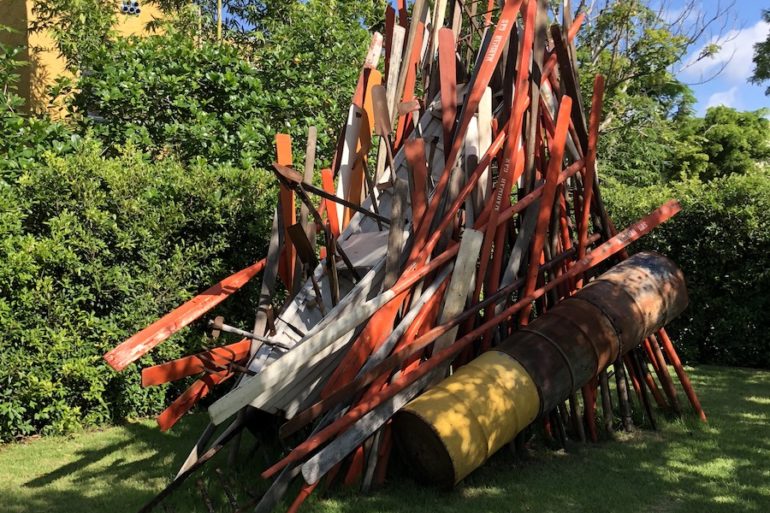
This post is also available in:

“The story that is usually told is the version of the winners. And it’s trash! “
This is the incipit of the meeting with Abigail DeVille at the ICA in Miami a few nights ago, for her performance as part of IDEA 009.
A thirty-seven-year-old native of New York, a highly respected curriculum with studies at the Pratt Institute in New York, the Skowhegan School of Painting and Sculpture, Maine, the Fashion Institute of Technology in New York and Yale University in Connecticut. Known for her large sculptures and installations, fortuitous fate, she arrived at the ICA in Miami for the interview all the way from Rome, Italy, where she is currently working. While she speaks interviewed by the Director of the ICA she does not hide her shyness, but it is in her sonorous and cheerful laugh that one understands how much determination there is in this girl. Abigail a half-way street historic, an archaeologist and an artist.
A weakness for large sculptures, large installations and processionals as she calls them. Processionals are performances that bring her art out of the exhibition space, through the streets of the city. She made one in Washington, D.C., in Baltimore and New York City and an example of it is The New Migration: Harlem, NY, 26 October 26.

Processionals concern immigration issues meant as both, a large movement of people in search of a better life, as happened for the great migration where people moved from the south to the north in search of a better world, and the current reverse process : gentrification. Gentrification is the process of renewal of degraded urban areas with consequent requalification of the territory, which is why residents who have long lived these spaces, can no longer afford the price increase due to the upgrading, and are evicted, with consequent prerogative of the structures by the most affluent. In this way the characteristic racial and ethnic composition of the place is changed. An example is Wynwood, who from the disused district has now become the artistic hub of Miami, but there are examples of gentrification in every part of the world, Milan, Chicago, Harlem,New York.
The work of Abigail DeVille The New Migration set up on the streets of Harlem in 2014 was inspired by the men and women of the Great Migration in the mid-1900s: 6 million African Americans escaped from systemic racism and the state of violence under the Jim Crow’s laws, who had created a deeply rooted culture of separation between whites and blacks. People moved because the chances in the South were so reduced that they moved to the masses of northern cities in search of better living conditions. The New Migration is interpreted by Abigail as a great procession of musicians, dancers, bands and members of the community of all ages who wear the sculptures created by the artist, composed of a network of a meter and a half, a set of domestic objects , like clothes, musical instruments, pots and pans, that is everything you have as you move from one place to another, that if you fall, falls with you. And that symbolically represents the weight of history.
According to Abigail: “one person’s trash is another’s treasure”. Starting from this principle it is not difficult to see Abigail DeVille with a shopping cart rummaging through garbage waste, in the degraded areas submerged by disused urban waste: wood, bins, sheets … Her work is in fact based on the collection of objects collected in the area surrounding the exhibition space, reconstructing its history, culture, sometimes their meaning and re-elaborating them in an artistic key. Objects that speak of stories often lost or forgotten and that she calls black holes or supernova.
She started thinking about supernovae around 2008: black holes as a device able to organize a large quantity of material made up of seemingly invisible stories and that, consequently, as invisible, could take any form. An example is the exhibition at the Contemporary Art Museum in St. Louis: centered around a large skeletal wooden dome inspired by the architectural structure of the local court where slaves were once sold and where Dred Scott sued the federal court , becoming an indirect catalyst for what was the next American civil war.

The discovery of books written by maternal grandfather Francisco Antonio Cruz, who unfortunately did not have the opportunity to know about the supernovae, encouraged her further in her project.
Most of her work concerns American history but she has also been in Norway to put the same project into practice. Much more difficult but the development process was the same: how people interact about a given thing, in relation to space; “I’m interested in telling invisible stories, to groups of people who occupied a space that no longer exists” this is what she says of herself and it is basically the summary of her art, a sort of mysticism that puts us in tune with the past.
